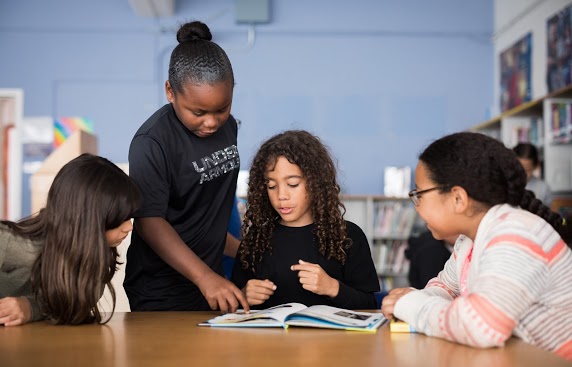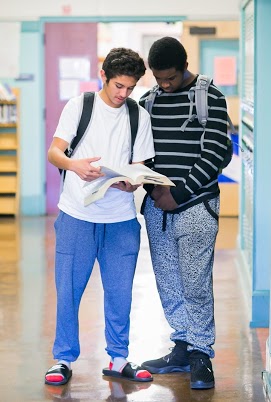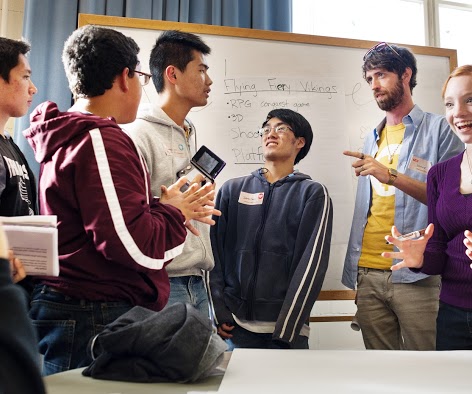Why bother with groupwork? Link to this section
 Group work can be difficult to design, manage, and assess, but we know it's an important skill for students to develop.
Group work can be difficult to design, manage, and assess, but we know it's an important skill for students to develop.
Employers consistently rank collaboration and teamwork skills among their top-rated, most desirable attributes when listing traits they look for during hiring (Duhigg, 2016; LaBouef, Griffith, & Roberts, 2016; Theobald, Eddy, Grunspan, Wiggins, & Crowe, 2017).
Is groupwork good for learning? Link to this section
 The honest answer is that it depends on the goals of the project. Research shows that students on average learn more content knowledge through individual projects than through group projects (Bacon, 2005); however, the sole purpose of a project in our classrooms is rarely, if ever, to only learn material. As teachers, we assign projects for students want students to both learn material and develop collaboration & organizational skills.
The honest answer is that it depends on the goals of the project. Research shows that students on average learn more content knowledge through individual projects than through group projects (Bacon, 2005); however, the sole purpose of a project in our classrooms is rarely, if ever, to only learn material. As teachers, we assign projects for students want students to both learn material and develop collaboration & organizational skills.
Group work can build many different types of social skills, including resourcefulness, interdependence, problem-solving, interpersonal communication, critical thinking, and project management (LaBeouf et al., 2016; Sedgwich, 2010). Group work is also shown to increase motivation and is incredibly valuable in cementing learning through interaction (LaBeouf et al., 2016; Theobald et al., 2017).
That being said, however, research found that group learning improves learning outcomes only when the assigned tasks have both group goals and individual accountability (Slavin, 1988). In addition, when learners divide up the work such that each member specializes in a task, such as one person does all the research and the other does all the writing, learners don't develop new skills. Instead, they means they use only the skills that they already know to find the path of least resistance to their grade, instead of learning new ones (Bacon, 2005).
Lastly, it's important to remember that not all students experience group work the same way (Theobald et al., 2017). In fact, research suggests that females learn more from group projects than males (Bacon & Novotny, 2002), and different students have unique learning preferences and skill sets. While group work can help students build cooperative skills and a sense of teamwork, the group needs to be purposefully structured and facilitated to see positive learning outcomes (Slavin, 1988; Theobald et al., 2017).
Characteristics of effective groups Link to this section
In 1988, Robert Slavin, a researcher and expert in collaborative learning, identified two conditions as being crucial for successful peer-learning: positive interdependence (via a group goal that's important to them) and individual accountability. Group goals provide motivation and give students a stake in each other's success. Individual accountability ensures that all group members are participating and are seen by all as valuable members of the group so that the success of the group depends on the individual learning of each group member.
Groups that have both of these things are considerably more likely to reach the learning outcomes for the project and to show improvement in their collaboration skills (Slavin, 1988). Groups without these two things often succumb to some form of social loafing, where the work is disproportionate because some students slack off while others do more (Bacon, 2005; Comer, 1995).

One of the biggest predictors of both individual and group success is students' level of comfort in the group, with content mastery increasing by 27.5% for learners who felt comfortable (Theobald et al., 2017). In fact, Google spent millions of dollars researching what makes a good team, and they found the same thing: what sets "good" teams apart is how the teammates treat each other to create psychological safety, or "a shared belief held by members of a team that the team is safe for interpersonal risk‐taking" (Duhigg, 2016).
It's clear the social dynamics of a group affect the members' academic performance (Theobald et al., 2017). Sharing airtime in the group and paying attention to the emotions of others in the group help the group establish an interpersonal bond (Duhigg, 2016), and in studies where groups who report having a "dominator" in the group, those groups do worse on assessments than groups who don't report having one (Theobald et al., 2017).
Learning from this research, a positive group culture can be cultivated in the classroom by allowing students to have at least some choice in their groups. Having a friend in their group is a monumental predictor of learner comfort and team success, and research shows that self-selected groups may actually be better for students from marginalized and minority groups. (Theobald et al., 2017).
As the teacher, you can also influence group performance by having groups establish norms of behavior and operation. You can also have the groups assign roles to each member because when the task requires equally valuable input from each role, this naturally creates interdependence through both group goals and individual accountability (Slavin, 1998; Theobald et al., 2017). When instructors design a complex task that's interesting to learners, while also managing student behavior, there is a potential for students to work together happily & productively in groups (Theobald et al., 2017).
Depending on the age of your learners, it may be beneficial to structure the work with explicit prompts guiding toward interdependence, such as “take turns,” “defend your answer,” and/or “probe your teammates for justification.” This purposeful guidance can help students work together more effectively and equitably (Theobald et al., 2017).
Deciding on group size Link to this section
 Group sizing can be tricky, but synthesized research shows smaller groups are usually better for student learning. As groups get bigger, each member has less opportunity to participate. This is called "production blocking", and it reduces the possible benefit of their participation (Bacon, 2005; Diehl & Stroebe, 1987). In addition, the peer-learning benefits from group dialogue also decrease in larger groups, and big groups often experience "coordination loss", which is the time and resources lost to attempts to coordinate the group's efforts (Bacon, 2005). Students often rate large group work projects as being more work than individual projects due to this inefficiency in coordinating schedules and unifying a plan (Bacon, 2005).
Group sizing can be tricky, but synthesized research shows smaller groups are usually better for student learning. As groups get bigger, each member has less opportunity to participate. This is called "production blocking", and it reduces the possible benefit of their participation (Bacon, 2005; Diehl & Stroebe, 1987). In addition, the peer-learning benefits from group dialogue also decrease in larger groups, and big groups often experience "coordination loss", which is the time and resources lost to attempts to coordinate the group's efforts (Bacon, 2005). Students often rate large group work projects as being more work than individual projects due to this inefficiency in coordinating schedules and unifying a plan (Bacon, 2005).
However, larger groups do offer one benefit less common in smaller groups. Big groups often have more group resources, such as a member who has experience with a certain task or someone in the group who understands a complex topic and could explain it to others (Bacon, 2005).
Ultimately, you as the instructor will need to determine which group size best meets the needs of the task(s) and your learning goals.
Tools for enabling group collaboration Link to this section
There are many tools that can help you manage groups and foster collaboration. Google Classroom offers the option to assign individual learners to an assignment. You could create an assignment for a group of students or for the member from each group playing a specific role in the group. Watch a video to learn more about assigning work to select students.
You can also use the version history in G Suite's core apps (Docs, Slides, & Sheets) to see what contributions each group member made and when. Learn more about version history in G Suite.
One way to collect a group's established norms and assigned roles is through Google Forms. Each group can fill out the form with their norms and the name of the person responsible for each role or task, and all the answers are compiled together for you in one place. Learn more about getting started with Google Forms.

Peer evaluation is a common practice for group work, but it can actually be counterproductive to building strong collaboration skills (Bacon, Stewart, & Silver, 1999). Teachers often use peer evaluation as a way to minimize social loafing behavior because they offer group members a chance to penalize free-riders without any direct confrontation. However, direct confrontation is one of the best ways to offer the necessary peer pressure and redirection that reduces social loafing behaviors in groups (Strong & Anderson, 1990), and it's also a valuable teamwork skill. You will likely need to structure for students the appropriate way to confront a group member who isn't doing their part, but it is much more effective that peer evaluations of group member contributions. If you work with older, more mature learners, research suggests allowing teams the option to go through a process to fire members is also incredibly effective at discouraging social loafing (Bacon et al., 1999; Kahn, 1995).
Instead of a peer evaluation, you could use Google Forms to collect both self- and group-reflections or to check in with groups. This would allow you a window into groups that may need more support and structure to build a team bond, create psychological safety, and/or appropriately confront a social loafer.
Another way to ensure all group members have the opportunity to participate in the group's work is to provide a collaborative space where all members can add their thoughts and input. Any of G Suite's core apps, such as Docs, Slides, Drawings, or Sheets, can be shared among group members and worked on simultaneously.
In addition, Jamboard is a collaborative whiteboard originally designed to be hardware, but the Jamboard app is now part of G Suite's core apps. The mobile app, which you can download for both iOS and Android devices, offers many features and tools to capture ideas, plan out different options, or to create mock-ups or prototypes, all of which students could work on together at the same time. You can even download the Android app on Chromebooks. To learn more, watch a video about what Jamboard can do.
References Link to this section
Bacon, D. R. (2005). The effect of group projects on content-related learning. Journal of Management Education, 29(2), 248-267.
Bacon, D. R., & Novotny, J. (2002). Exploring achievement striving as a moderator of the grading leniency effect. Journal of Marketing Education, 24, 4-14.
Bacon, D. R., Stewart, K. A., & Silver, W. S. (1999). Lessons from the best and worst student team experiences: How a teacher can make the difference. Journal of Management Education, 23, 467-488.
Comer, D. R. (1995). A model of social loafing in real work groups. Human Relations, 48, 647-667.
Diehl, M., & Stroebe, W. (1987). Productivity loss in brainstorming groups: Toward the solution of a riddle. Journal of Personality and Social Psychology, 53(3), 497-509.
Duhigg, C. (2016, February 28). What Google learned from its quest to build the perfect team. The New York Times Magazine.
Kahn, W. (1995). Group process checkpoints for team learning in the classroom. Journal of Policy Analysis and Management, 14, 310-326.
LaBeouf, J. P., Griffith, J. C., & Roberts, D. L. (2016). Faculty and student issues with group work: What is problematic with college group assignments and why? Journal of Education and Human Development, 5(1), 13-25.
Sedgwich, P. (2010). Reflections of a “progressive” teacher in higher education: The opportunities involved in giving students control. CETL AFL Occasional Papers. No. 5. Newcastle upon Tyne, UK: Centre for Excellence in Assessment for Learning, North Umbria University.
Slavin, R. E. (1988). Cooperative learning and student achievement. Educational Leadership, 46, 31-33.
Strong, J. T., & Anderson, R. E. (1990). Free-riding in group projects: Control mechanisms and preliminary data. Journal of Marketing Education, 12, 61-67.
Theobald, E. J., Eddy, S. L., Grunspan, D. Z., Wiggins, B. L., & Crowe, A. J. (2017). Student perception of group dynamics predicts individual performance: Comfort and equity matter. PloS one, 12(7), 1-16.
This page was last updated on March 9, 2021

